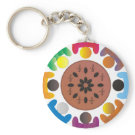What's the "Lowest Common Denominator"?

So you've heard the term "Lowest Common Denominator" but you're not quite sure what it is. It is a math term, but it's also used to mean "something of small intellectual content designed to appeal to a lowbrow audience ; also : such an audience" (according to http://www.merriam-webster.com/dictionary as of September 15, 2008).
But in math, it refers to a something needed for addition or subtraction of fractions.
When you need to add two fractions, the denominators (the bottom number in a fraction) need to be the same number. For example, you can add 3/5 to 4/5 because the denominator is the same (3/5 4/5 = 7/5).
But if the denominators don't match (like 3/5 and 1/6) then you have make them match.
Finding The Lowest Common Denominator, Part I
Factoring Numbers
 When you need to find the Lowest Common Denominator, the first thing you need to do is factor the two denominators (You'll understand why later). Let's say we have two fractions, 3/78 and 5/98. We need to add these two fractions and they don't have the same denominator.
When you need to find the Lowest Common Denominator, the first thing you need to do is factor the two denominators (You'll understand why later). Let's say we have two fractions, 3/78 and 5/98. We need to add these two fractions and they don't have the same denominator.The first thing you need to do is factor 78 and 98 into their prime factors (Note: if a number in the denominator is already a prime number you would
Next we do the same thing with 98. Since 98 is also an even number, the first thing we would do is divide it by 2. 98/2= 49. Then we would divide 49 by another number that might go into it. Since 49 is odd, we know 2 doesn't go into it. So we try 3 (the next prime number after 2), but that doesn't work. So we try 7 (since we know 5 won't work) and sure enough, 7 goes into 49 -- 49/7 = 7. 7 is a prime number.
Finding the Lowest Common Denominator, Part II
 So now that we have the two denominators factored, we have to use that factoring to figure out what the Lowest Common Denominator is.
So now that we have the two denominators factored, we have to use that factoring to figure out what the Lowest Common Denominator is.If you notice in the graphic, both factor lists have a 2 (circled in green). So when you multiply out to find the Lowest Common Denominator, you only include one 2. You then make sure you have at least one 3, two 7s and one 13 (see the factors to the side). When you multiply this all out, you get 3822. This would be the Lowest Common Denominator.
That is a bit of an extreme example, so I'll quickly show you another example. Let's say we have to add three fractions -- 5/12, 3/8, and 2/9. 12= 2 X 2 X 3 (two 2s and one 3), 8= 2 X 2 X 2 (three 2s) and 9= 3 X 3 (two 3s). We look at what we have and we take the largest number of each number that appears in any one of the factor lists (so we'd take three 2s to cover the 2s in 8; and two 3s to cover the 3s in 9; both will cover the factors in 12) -- this would give us 72 (2 X 2 X 2 X 3 X 3 = 72) -- so the 5/12 become 30/72 (12 X 6 = 72, 5 X 6 = 30), 3/8 becomes 27/72 (8 X 9 = 72, 3 X 9 = 27), and 2/9 become 16/72 (9 X 8 = 72, 2 X 8 = 16). Add them up and you get:
30/72 + 27/72 + 16/72 or 73/72.
How to find out if a number is prime
 If you want to find out if a number is prime, you don't have to try to divide it by every number up to that number. (This would be really time consuming, even using [the bane of my existence] a calculator if you are trying to find out if a number such as 57,967 is prime!). First of all, 2 is the only even prime number, so other than 2, there are no even prime numbers. Second of all, any number ending in a "5" is divisible by 5 (15 is 3 X 5, 25 is 5 X 5, 35 is 7 X 5, etc.) so, other than 5 itself (which is prime) no number ending in a "5" is prime.
If you want to find out if a number is prime, you don't have to try to divide it by every number up to that number. (This would be really time consuming, even using [the bane of my existence] a calculator if you are trying to find out if a number such as 57,967 is prime!). First of all, 2 is the only even prime number, so other than 2, there are no even prime numbers. Second of all, any number ending in a "5" is divisible by 5 (15 is 3 X 5, 25 is 5 X 5, 35 is 7 X 5, etc.) so, other than 5 itself (which is prime) no number ending in a "5" is prime.So, in order for a number to be prime (other than 2 and 5), it has to end in 1,3,7 or 9 (as you can see from the graphic on the side which shows the prime numbers from 0 to 100 -- 1 is not considered a prime number).
Another thing you have to understand is that composite numbers (that is numbers that are not prime) are divisible by at least two numbers (other than 1 and themselves). At least one of those number has to be either the square root of the number or less than the square root of the number.
[to illustrate this, let's take a few examples -- 39, for example, the square root of 39 would be greater than 6 (6X6=36) and less than 7 (7X7=49) -- so at least one of the numbers that 39 is divisible by, if it is composite, would be less than 7. So first you try 3, which 39 is divisible by, so 39 is not prime.
41, for example, the square root of 41 would be greater than 6 (6X6=36) and less than 7 (7X7=49) -- so at least one of the numbers that 41 is divisible by, if it is composite, would be less than 7. So first you try 3, which 41 is not divisible by (3X13=39, 3X14=42) then you try (since we know 41 is not divisible by 5 or any even number) 7, which 41 is notdivisible by (7X5=35, 7X6=42), so 41 is prime.]
Next, you only have to try dividing a number by prime numbers (since a number that is not divisible by 3, for example, won't be divisible by 6, 9, 12, 15, 18, 21 or any other number that 3 goes into) -- so that means you need to try dividing by 3, 7, 11, etc. (5 only goes into numbers that end in "0" and "5" like 55 or 110 or 9875 or 30670 and only even numbers are divisible by 2). This makes figuring out if something is prime a lot faster than trying every number.
By the way, 57,967 is not prime -- it equals 7 X 7 X 7 X 13 X 13.




No comments:
Post a Comment